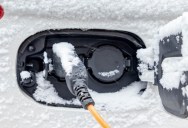New Lithium-Ion Battery Performs At -140F And Can Charge In Just 10 Minutes

Many of the electronics we use on a regular basis are powered by lithium batteries. There are a few reasons they’re superior to the previous type: they charge faster, last longer, and have a higher power density and longer battery life.
There are places we haven’t been able to upgrade, though, because of their current sensitivity to heat and cold.
This new battery could give us the chance to use them in extremely cold environments, like on aircraft.
Currently, lithium batteries charge more slowly and store less energy at lower temperatures. This is a reason people who live in colder climates avoid the idea of electric vehicles, even though plenty of people in Norway have made the switch without incident.

That said, the altitudes that most commercial aircraft cruise at necessitates a power source that can withstand pretty cold temperatures.
Professor Xiulin Fan, along with his team at Zhejiang University, say they made an electrolyte using “small-sized solvents with low solvation energy,” which should solve the main issue.
Existing electrolytes start to have trouble as temperatures get lower than 77°F. They don’t freeze, but they carry fewer charges and performance is reduced the lower temperatures drop.
This team found that three small-sized solvents can for Li+ transporting channels that facilitate faster ion movement and one, fluoroacetonitrile, meets all of the other necessary criteria as well.
They’ve dubbed them FAN electrolyte batteries, and they’re showing outstanding ionic conductivity not only at room temperature, but all the way down to -112°Fto -140°F.
They outperform alternatives at temperatures as low as -94°F.
In human speak, the batteries “can be charged in 10 minutes to reach 80 percent of charge capacity” at lower temperatures than ever before.

They say this achievement is due to the two layers, or sheaths, around the lithium ions that are smaller and more transportable than those in dilute carbonate electrolytes.
Fan’s team believes their tech is “generalizable and can be expanded to other metal-ion battery electrolytes,” which is good news for cold-weather grid operators.
Time will tell whether or not this makes a big impact, but it certainly seems set to do just that.
If you think that’s impressive, check out this story about a “goldmine” of lithium that was found in the U.S. that could completely change the EV battery game.

Sign up to get our BEST stories of the week straight to your inbox.




